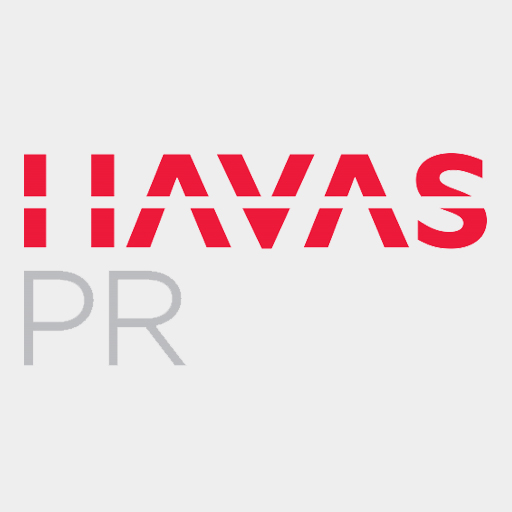
The Influence 100: Introduction & Methodology
The Profiles | The Research | The Social Profile
Analysis: Are In-House PR Leaders Using Twitter Enough?The Research: Budgets, Agencies & Inspiration
The following research is based on a survey of those selected for inclusion in this year’s Influence 100 and our own analysis and research.
The 100
GeographyThe world’s 100 most influential corporate communicators is a diverse group. Compared to last year, there are 22 new entrants in this year’s compilation. This is down to a variety of factors, including job changes (several of last year’s Influence 100 have left their roles) and the rise of certain executives, companies, industries and regions. Unsurprisingly, given the size and stature of the US public relations industry, 50 of them are based in North America (compared to 48 in 2013), with a further 12 located in the UK. The remainder are spread across 23 countries around the world, including Brazil, China, India, Indonesia, Japan, Korea, Russia, Singapore, South Africa, Saudi Arabia and the UAE as well as all of the major markets in Western Europe.
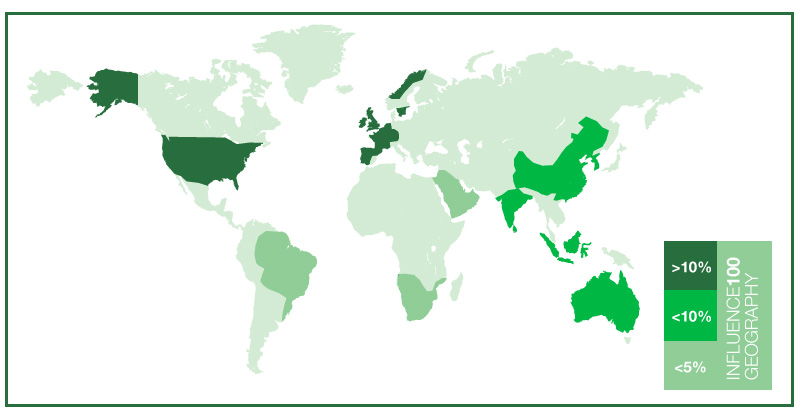 Sectors
Sectors They represent a wide range of industries — technology, automotive and aviation, e-commerce, healthcare, mining and manufacturing, retailing, food and beverage — as well as public sector organizations such as the White House and EU.
 Tenure
TenureThe tenure of Influence 100 communicators is, on average, 9.5 years. Nineteen percent have been with their companies for less than three years. McDonald’s Robert Gibbs, Amazon’s Jay Carney, Shire’s Michele Galen and Uber’s Rachel Whetstone stepped into their new roles this year.
Nearly two-thirds (64%) have been with their companies for less than decade. The remaining 36% count considerable tenures at their organizations, including 12 who have been with the same company for more than 20 years, including: ExxonMobil’s Ken Cohen; J&J’s Michael Sneed; Emirates’ Boutros Boutros; FedEx's Michael Glenn ; L’Oreal’s Beatrice Dautresme; IBM’s Jon Iwata; Saudi Aramco’s Khalid Abubshait; P&G’s Marc Pritchard; LG’s Kim Young-kee and Americans Express’ Mike O’Neill.

GenderLike the agency side of the business, we found a considerable gender disparity among those who hold the top communications role at many of the most influential companies around the world. Only 33% are women, meanwhile 67% were men. It is estimated that 70% of the PR workforce is made up of women.
 The Budget
The Budget
Slightly less than one-third (27%) report they oversee total PR budgets greater than $100m — down from exactly 50% in the previous year. About 11% peg their budget between $75m and $100m and the same number report budgets in the $50m to $75m range. About one-third oversee budgets between $10m and $50m, meanwhile 11% report a budget between $5m and $10m and the remaining (5.6%) report less than $5m. This means the 100 most influential corporate communicators in the world are likely responsible for budgets well in excess of one billion dollars.
Slightly more than 40% said their budgets increased last year. Slightly more than one-third reported a contracting budget and nearly a quarter had budgets that remained flat. A staggering 71% expect to increase their spend on content development and marketing this year — a striking contrast to 2013 when 80% expected to spend more on social media. This year, only 67% reported to grow their social media spend. Just shy of 50% expect to up their spend on PR/corporate reputation, 38% look to add resources to digital marketing and analytics respectively. Other investment areas: advertising (24%), experiential (19%), sponsorship (14.3%) and CRM (5%).
The Agencies
Unsurprisingly, 100% of those responding to our survey reported they were the individual primarily responsible for hiring and firing public relations firms.
And once again, many of them reported that they were a primary decision maker when it came to other external communications spending: 70% play a key role in hiring digital and social media firms (on par with last year); 45% play a role in sponsorship decisions (down from from 57%); 65% have a role in hiring event management companies (up from 52%); meanwhile 40% (down from 48%) are the primary decision maker when it comes to hiring advertising agencies.
Only 5% work with just one global agency of record — on par with last year. Nearly one-third (32%) enlist a global AOR, plus other support agencies. About one-in-four opt to have regional AORs, just north of one-quarter select agencies based on market and 16% work with agencies on project basis — down significantly from last year (35%).
The majority (55%) prefer to hire their agency through an invitation-only pitch, meanwhile sticking with a previous agency and going through an RFI/RFP process each nabbed 20%. Only 5% prefer to rely on referrals.
Perhaps refreshingly, 43% rely on their agencies for idea generation — and nearly one-quarter look to their partners for strategic counsel and direction. Twenty-eight percent are looking for tactical support and just 5% report geographic coverage as their primary driver for enlisting agencies.
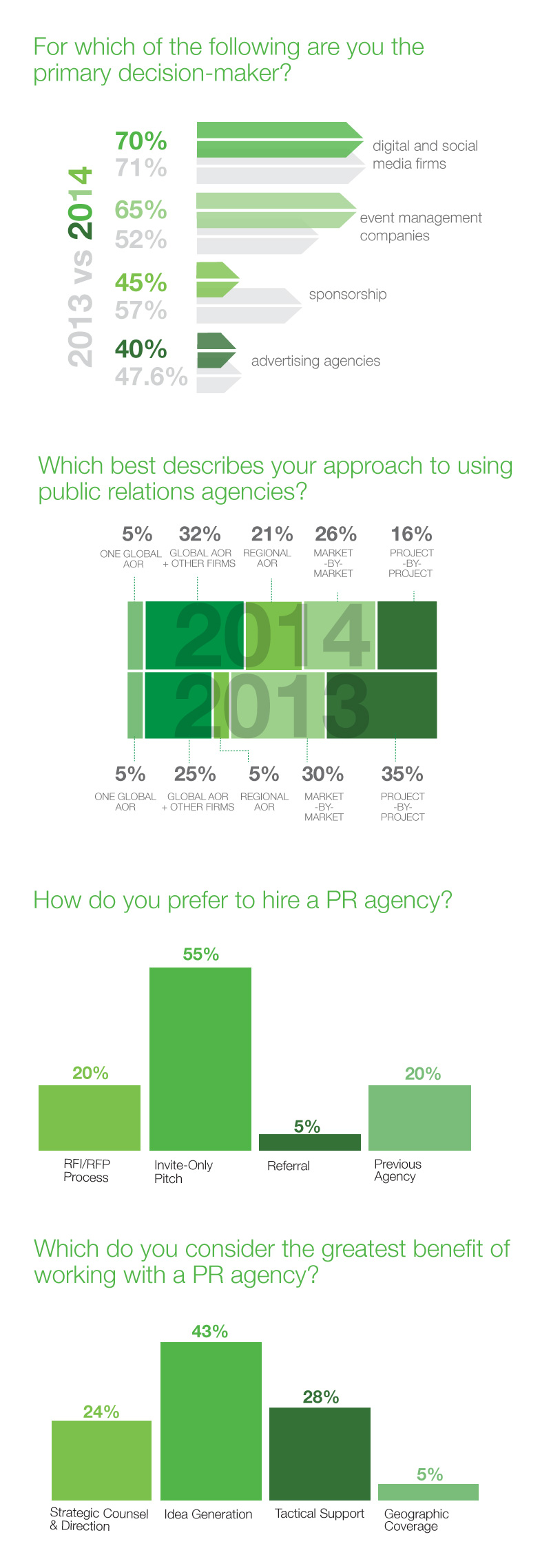 The Inspiration Favorite Brands
The Inspiration Favorite BrandsAsked to identify companies—other than their own—that managed brand communications effectively, there were some striking changes from last year. Apple, IBM and Disney re-emerged after being notably absent last year. Unilever, BMW, Volkswagen and Coca-Cola appeared once again. Also on the list this year: GE, Google, Nike, Burberry and Virgin America.
 Reputation Excellence
Reputation Excellence
When asked which companies handle their corporate reputation most effectively, GE was the most popular answer (which was also on the list last year). Other companies that made an impression: Google, Unilever, Southwest Airlines, Tata Group, Disney, IBM, Coca-Cola, Johnson & Johnson, Allianz, Deutsche Bank, Whole Foods, Starbucks and Nike. Notably missing from last year: Shell, BMW, John Lewis, Ford, Apple, Red Bull, Chevron, Greenpeace and Virgin.
 Favorite Communicators
Favorite Communicators Pope Francis was the most popular choice for favorite communicator, followed by Barack Obama. Angela Merkel, Bill Clinton, Warren Buffett and Howard Schultz also reappeared on the list. New this year: Tony Fernandes, Tim Cook, David Brooks, Bill Gates and Alan Mulally.
 Industry Reputation
Industry Reputation When asked which marketing or communications executive was most innovative, Richard Edelman and IBM’s Jon Iwata made the list again. Other names were Nike’s Trevor Edwards, Uber’s Rachel Whetstone, the NBA’s Pam El, Virgin America’s Luanne Calvert, ExxonMobil’s Suzanne McCarron and former Edelman president Mark Hass.
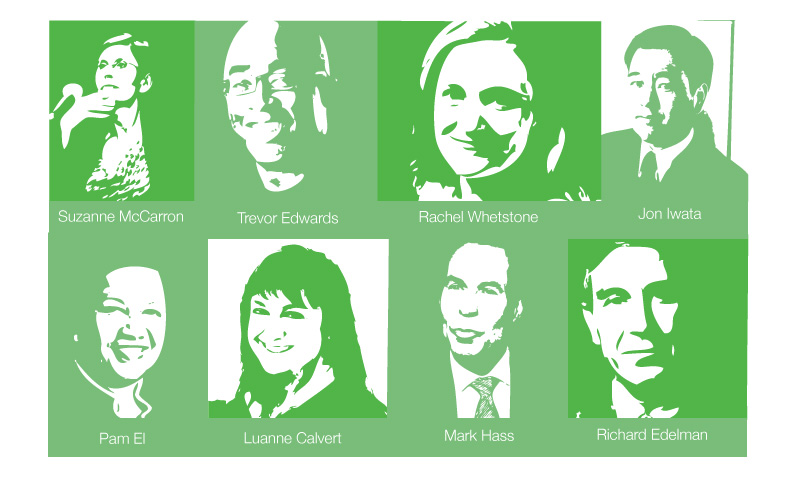
Edelman was — for three years in a row — the most frequently cited public relations agency when respondents were asked which firm they most admired. Burson-Marsteller was also mentioned more than once. The only other global, multi-service firms to make the cut was Weber Shandwick and the WPP network (while FleishmanHillard and Hill + Knowlton made the list last year, they did not appear this year). Brunswick, FTI, the OutCast Agency, Portland and Glover Park.
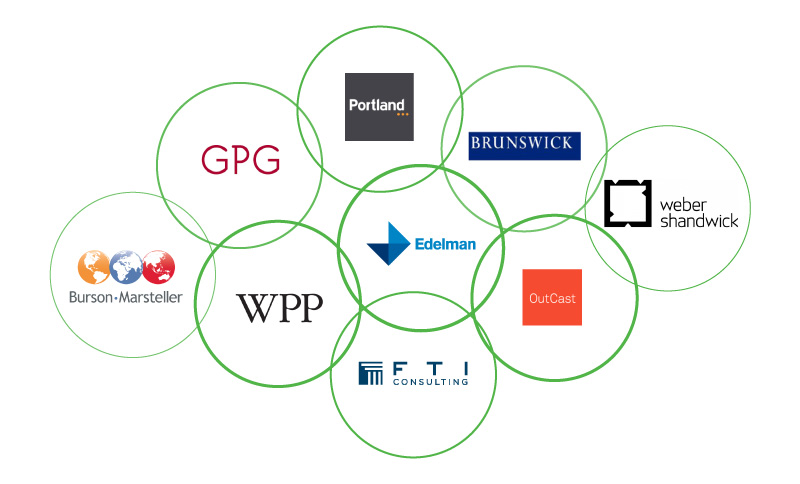 The Organization
The Organization About 60% of the Influence 100 report to the chairperson or CEO of their organization; just north of 13% report to the chief marketing officer. The remainder (27.3%) report elsewhere.
PR/corp comms has primary responsibility of social media at 57% of the organizations. For 19% marketing ruled social media and for another 19% it was a shared responsibility.
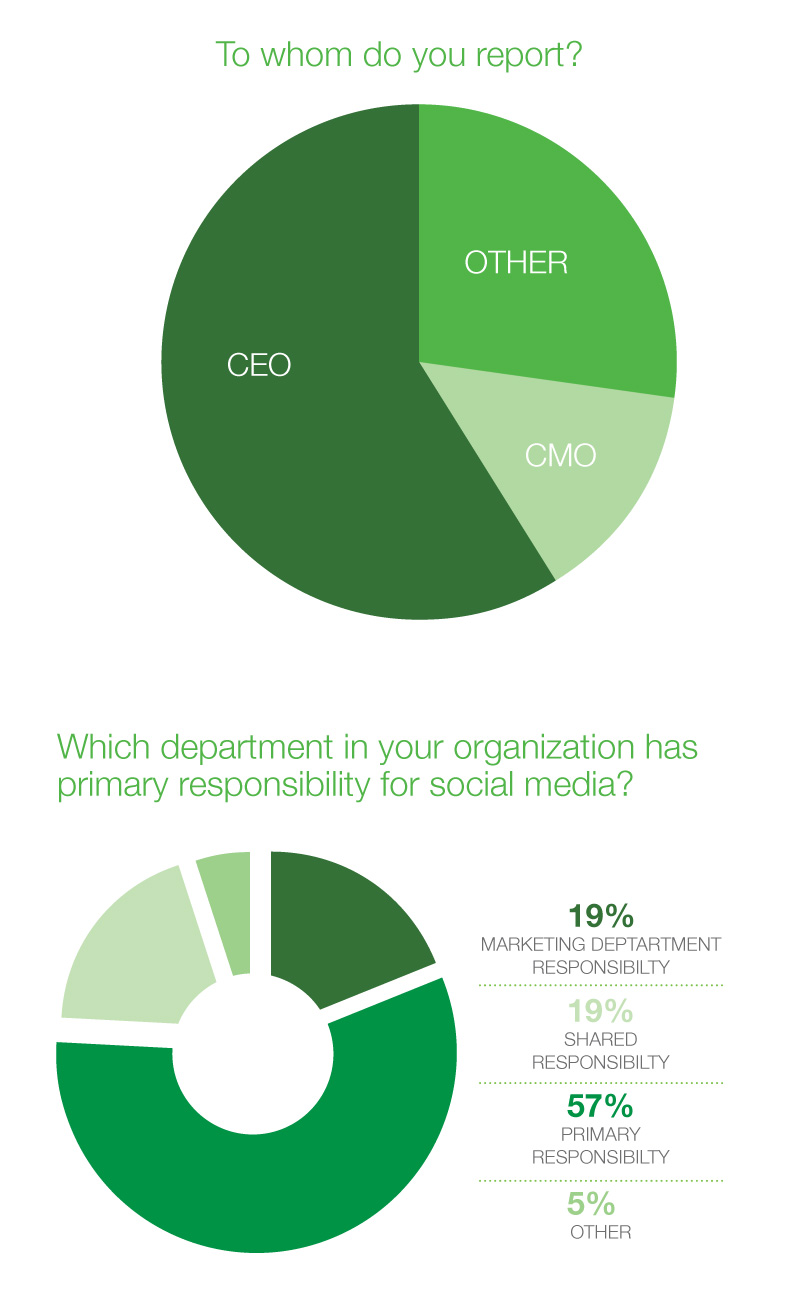
The TeamSixty-five percent of respondents manage teams of more than 100 people, while one-quarter manages teams between 21 to 100. Ten percent of the respondents oversee teams of 20 or less. The agency hiring craze also seems to apply in-house: half of respondents increased their team last year; 44% remained flat and only 6% lowered headcount.
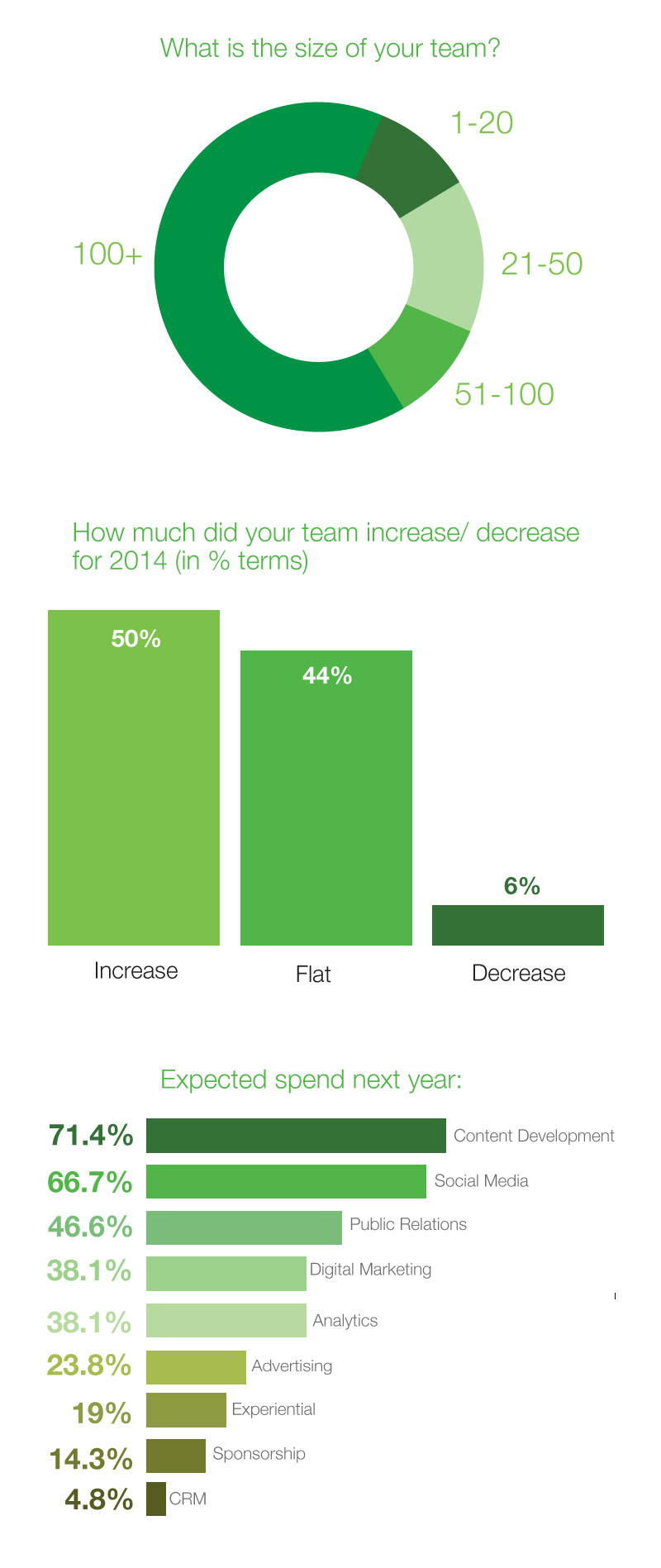
The Early Days
Education & First Career Based on a survey of those selected for inclusion in this year’s Influence 100, 57% have advanced education beyond a bachelor’s degree. Journalism and communications were the most popular field of study, followed by political science, business and the liberal arts. The Influence 100 also includes individuals with degrees in law and the sciences, among others. About 40% selected public relations as their first career — up from about 30% in the same survey in 2013 and 48% in 2012.
 Experience
Experience Our own analysis of the Influence 100, reveals that only 31% have experience working on the agency side of the business. Meanwhile, 35% had experience working in politics — only 11% had experience working in both politics and on the agency side, among those: Robert Gibbs, Henry Gomez and Jim Wilkinson. Thirteen percent worked in media and only person from the Influence 100 — Stephen Doherty — worked across agency, politics and media.
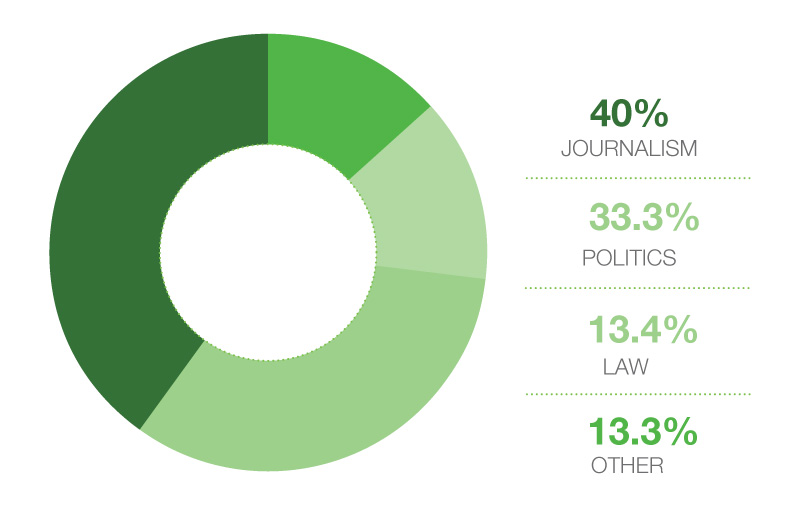 The Influence 100: Introduction & Methodology
The Influence 100: Introduction & Methodology
The Profiles | The Research | The Social Profile Analysis: Are In-House PR Leaders Using Twitter Enough? 
 Podcasts
Podcasts Videos
Videos Profiles & Interviews
Profiles & Interviews Crisis Review
Crisis Review Coronavirus
Coronavirus Trend Forecasts
Trend Forecasts Social & Digital
Social & Digital Technology
Technology Consumer
Consumer Employee Engagement
Employee Engagement Sports Marketing
Sports Marketing  Global PR Agency Rankings
Global PR Agency Rankings Agencies of the Year
Agencies of the Year Innovator 25
Innovator 25 Creativity in PR
Creativity in PR Asia-Pacific Communication Index
Asia-Pacific Communication Index SABRE Awards
SABRE Awards PRovokeSummit Global
PRovokeSummit Global PRovoke Media Regional Series
PRovoke Media Regional Series Agencies of the Year
Agencies of the Year Roundtables
Roundtables Agency Playbook
Agency Playbook.jpg) All Jobs
All Jobs




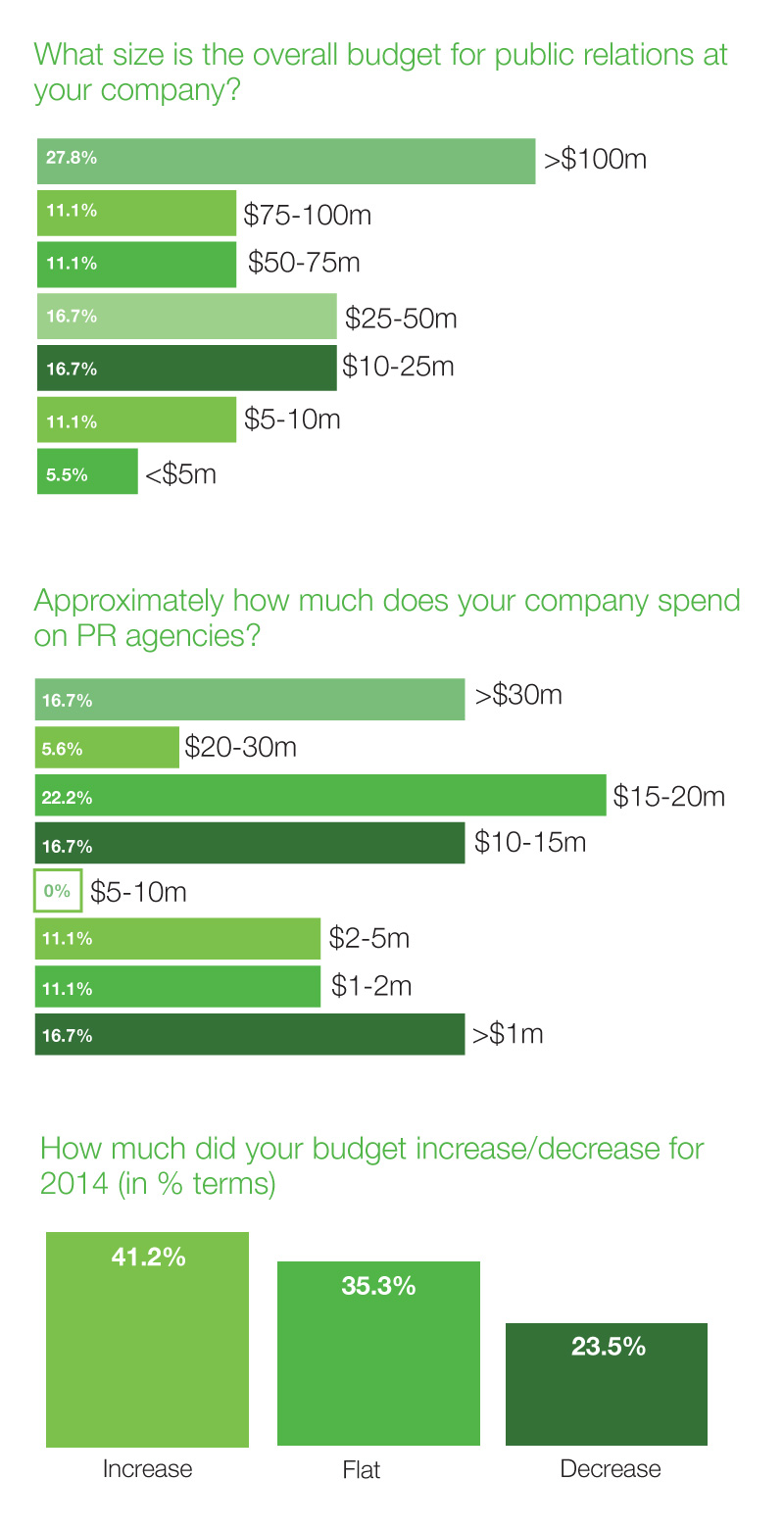









 The Influence 100: Introduction & Methodology
The Influence 100: Introduction & Methodology 
